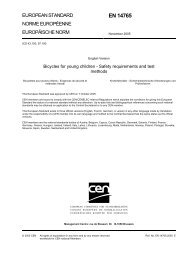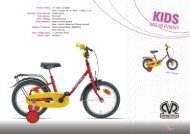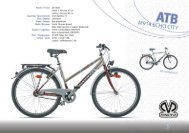EN 14766:2005 - 64_e_stf - Baltik vairas
EN 14766:2005 - 64_e_stf - Baltik vairas
EN 14766:2005 - 64_e_stf - Baltik vairas
- No tags were found...
Create successful ePaper yourself
Turn your PDF publications into a flip-book with our unique Google optimized e-Paper software.
<strong>EN</strong> <strong>14766</strong>:<strong>2005</strong> (E)4.14.3 Seat-pillar – Insertion-depth mark or positive stopThe seat-pillar shall be provided with one of the two following alternative means of ensuring a safe insertion-depthinto the frame:a) it shall contain a permanent, transverse mark of length not less than the external diameter or the majordimension of the cross-section of the seat-pillar that clearly indicates the minimum insertion-depth of the pillar intothe frame. For a circular cross-section, the mark shall be located not less than two diameters of the pillar from thebottom of the pillar (i.e. where the diameter is the external diameter). For a non-circular cross-section, the insertiondepthmark shall be located not less than 65 mm from the bottom of the pillar (i.e. where the seat-pillar has its fullcross-section).b) it shall incorporate a permanent stop to prevent it from being drawn out of the frame such as to leave theinsertion less than the amount specified in a) above.4.14.4 Saddle/seat pillar – security test4.14.4.1 Saddles with adjustment-clamps4.14.4.1.1 RequirementWhen tested by the method described in 4.14.4.1.2, there shall be no movement of the saddle adjustment clamp inany direction with respect to the pillar, or of the pillar with respect to the frame.4.14.4.1.2 Test methodWith the saddle and seat-pillar correctly assembled to the bicycle frame, and the clamps tightened to the torquerecommended by the bicycle manufacturer, apply a force of 650 N vertically downwards at a point 25 mm fromeither the front or rear of the saddle, whichever produces the greater torque on the saddle-clamp. Remove thisforce and apply a lateral force of 250 N horizontally at a point 25 mm from either the front or rear of the saddle,whichever produces the greater torque on the clamp (see Figure 48).4.14.4.2 Saddles without adjustment-clampsSaddles which are not clamped, but are designed to pivot in a vertical plane with respect to the pillar, shall betested by the method described in 4.14.4.1.2 and shall be allowed to move within the parameters of the designwithout failure of any components.74







